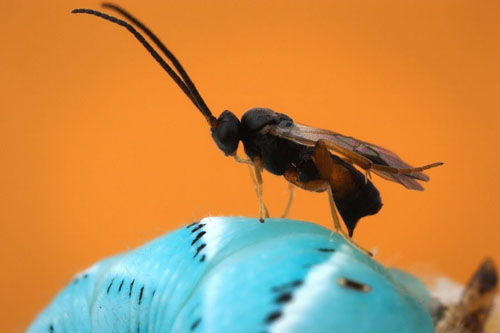Descriptive taxonomy of Microgastrinae
Our group, along with collaborators, has been highly active in describing the diversity of microgastrine wasps being discovered through tropical inventories, especially in the neotropics. In just the last five years, we’ve published descriptions of over 600 new species of braconid parasitoid wasps, along with several new genera, and several hundred more new species and additional new genera are already being worked on. Most of the species we have focused upon are microgastrine parasitoids of larval Lepidoptera, for which massive rearing studies have revolutionized our knowledge over the past few decades.
Comparative genomics of microgastrine wasps and their bracoviruses
One of our collaborations has been with Mike Strand’s and Gaelen Burke’s labs at the University of Georgia, and Hugh Robertson’s lab at Illinois, in providing the first well-assembled and annotated genome of a microgastrine wasp, and clarifying the organization of the genome of its bracovirus within it (see Selected recent publications).
Another collaboration has been with the laboratories of Alan and Emily Lemmon at Florida State University in assembling an anchored hybrid enrichment (AHE) dataset for Microgastrinae. Currently we have a 370-gene data set for just under 100 taxa, on our way towards a goal of roughly 800 taxa for analysis. The AHE data seem to be excellent for very confidently resolving monophyly of the microgastrine genera, and we are hoping that when taxon sampling is more complete, the intergeneric relationships will be more clear as well. Early phylogenetic results for this group suggested that the diverse microgastrine genera radiated rapidly roughly 50 millions years ago, so resolving the relationships may be challenging. The lab is also collaborating with several French laboratories (Jean-Michel Drezen, IRBI, Tours; Ann-Nathalie Volkoff, INRA, Montpellier) on comparative genomics of polydnavirus-bearing wasps.
Pipelines for visualizing, filtering and analyzing phylogenomic data for coalescent-based analyses
We are collaborating with Siavash Mirarab and Erfan Sayyari at San Diego State University on developing methods for optimizing phylogenomic data for coalescent-based analyses (combining gene trees using summary methods such as ASTRAL II). Erfan has developed a visualization and analysis pipeline called DiscoVista (available on GitHub ), and used this pipeline to analyze the effects of fragmentary data on the Misof et al 2014 insect transcriptomic dataset analysis (our paper is now published online at Molecular Biology and Evolution; the DiscoVista methods paper is in review at Molecular Phylogenetics and Evolution).
Tritrophic Cascades
One of our interests in the Whitfield lab is learning about how the natural history of microgastrine wasps has shaped their evolutionary history. We are working on a collaborative project towards this interest with colleagues at the University of Neveda Reno, the University of Cincinnati, and Wright State University. We are constructing phylogenies of Neotropical plants, insect herbivores, and parasitoids of those herbivores. Currently we are focuses on Piper plants, a genus of understory plants that produce an unusual diversity of secondary metabolites, Eois caterpillars, a genus of geometrid caterpillars that specialize on Piper, and the microgastrine wasps that attack Eois caterpillars. Initially, we identified the majority of microgastrine wasps reared from Eois caterpillars as members of the genus Parapanteles. From molecular results Kyle Parks has been getting, while most of these wasps seem to form one main monophyletic clade within the larger genus Dolichogenidea, other species seem to belong to several genera. As we improve our understanding of the molecular systematics of these wasps, we will use this information to develop testable hypotheses to understand how the intimate relationship between an endoparasitoid and its host caterpillar, and if the plant the host caterpillar eats influences the evolution of parasitoids.
Lizzy Dabek’s activities
I’m an undergraduate at University of Illinois at Urbana-Champaign currently working in the Whitfield and Berenbaum labs. My current research interests include parasitoid behavior and systematics, annotating the genome of Platygastroidea: Scelionidae, and the feeding mechanisms used by Galleria mellonella (wax moth) to digest and extract nutrients from bees wax and other simple lipids.
I am the president of Club Insecta, the undergraduate entomology club on campus. My goal is to spread a deeper understanding of insects and instill awe, respect, and wonder in the people I meet. When I studied abroad in Botswana my freshman year in university, I discovered a new species of Collembola which is in the works of being my first ever publication.
My hobbies include cycling, making music, writing, cooking, traveling, and photography. My photography website is https://500px.com/lizzydabek. I aspire to be a professor of entomology one day!
